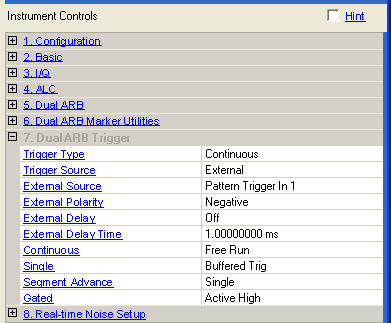

Choice: Continuous | Single | Gated | Segment Advance
Default: Continuous
This cell selects the triggering mode.
Continuous – selects the continuous triggering mode, which enables the instrument to repeat the modulating signal indefinitely until you turn off the modulation format, change triggers or select another waveform.
Single – sets up a waveform to play once after receiving a trigger. See Retrigger Modeto configure the waveform's response to triggers.
Gated – sets the instrument to the gated trigger mode, which causes the waveform (modulating signal) to repeatedly start and stop in response to an externally applied trigger signal. To use the gated trigger mode, you must also select .
Segment Advance – controls the way the instrument plays segments within a sequence. This includes determining whether a segment plays once or continuously, and when the sequence advances to the next segment. See also Segment Advance Mode.
Choice: Trigger Key | External | Bus
Default: External
This cell adjusts the trigger source applied to the or connectors.
Trigger Key – selects the front panel hardkey as the trigger source. After making this selection, press the hardkey to trigger a waveform.
Bus – enables the sending of a command through the GPIB, LAN or AUXILIARY IO (RS-232) input connector to trigger a waveform.
External – causes a waveform to trigger from an externally supplied trigger signal.
Choice: Pattern Trigger In 1 | Trigger Pattern In 2
Default: Pattern Trigger In 1
This cell selects the rear-panel input for the external trigger signal. must be selected as the trigger source.
Pattern Trigger In 1 – selects the PATTERN TRIG IN rear-panel BNC connector
Pattern Trigger In 2 – selects the AUXILIARY I/O rear panel connector
Choice: Positive | Negative
Default: Positive
This toggles the polarity of the TTL signal at the rear panel TRIGGER OUT connector.
Positive – the trigger out signal is asserted high (+ 5.0 V) at the start of the swept-sine modulation sweep and low (0 V) when the sweep ends.
Negative – reverses the polarity, so that the trigger out signal is low (0.0 V) at the start of the swept-sine modulation sweep and high (+ 5.0 V) when the sweep ends.
Choice: On | Off
Default: Off
This cell turns the external trigger delay off or on. The selection is active only after selecting as the trigger source.
Range: 10 ns to 40 ns
Default: 1 ms
This cell sets the amount of time to delay the instrument's response to an external trigger, in 10 ns steps. The delay is a path (time) delay between the time the instrument receives the trigger and when it responds to the trigger.
Choice: Free Run | Trigger & Run | Reset & Run
Default: Free Run
This cell selects the waveform's response to triggers when Continuous is the trigger mode (continuous waveform transmission.)
Free Run – immediately triggers when you turn the format on.
Trigger & Run – waits for and starts on the first trigger; ignores subsequent triggers.
Reset & Run – waits for and starts on the first trigger; resets and plays on a subsequent trigger.
Choice: Buffered Trigger | No Retrigger | Restart on Trigger
Default: Buffered Trigger
This cell configures the waveform's response to triggers while using the single trigger mode. The response selections determine whether the waveform accepts a trigger during playback, and if it does, how it responds to that trigger.
No Retrigger – causes the waveform to ignore the triggers during playback.
Buffered Trigger – causes a waveform to accept a trigger during payback and to restart after the current play finishes.
Restart on Trigger – causes a waveform to accept a trigger during playback and to restart immediately after receiving a trigger.
Choice: Single | Continuous
Default: Continuous
This cell configures how play moves from segment to segment within a waveform sequence.
Single – causes a segment to play once and wait for a trigger before the sequence advances to the next segment.
Continuous – causes a segment to play continuously until receiving another trigger. Upon receiving the trigger, the sequence advances to the next segment, which then plays continuously.
Choice: Active High | Active Low
Default: Active High
Sets the instrument to the gated trigger mode, which causes the waveform (modulating signal) to repeatedly start and stop in response to an externally applied trigger signal. To use the gated trigger mode, you must also select External.
Sets the trigger active state for the gated trigger mode.
Gate Active = High
Trigger Signal State = High
Waveform file stops playing.
Gate Active = High
Trigger Signal State = Low
Waveform file plays.
Gate Active = Low
Trigger Signal State = High
Waveform file plays.
Gate Active = Low
Trigger Signal State = Low
Waveform file stops playing.